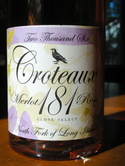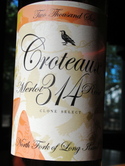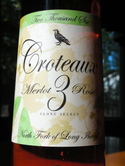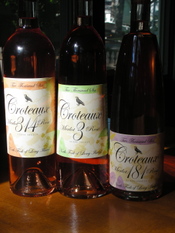As the Long Island wine community has moved into adolescence, several smaller wineries have popped up on the Island — some focusing on a single style or even one wine. Sparkling Pointe, for instance, has released it’s first — you guessed it — sparkling wines. And, Medolla Vineyards, for now anyway, is making merlot.
And then there is Croteaux Vineyards, a new producer owned by Michael and Paula S. Croteau. They focus solely on merlot-based rose wines, and they make three of them.
While a new winery, Mr. Croteau is no stranger to Long Island wine scene. As creative director of Croteau Design, he has designed logos and labels for many local wineries. His eye for design comes through not only in the labels for his own wines, but also in the bottles themselves, two of which are uniquely shaped.
The Croteaus grow merlot, cabernet franc and sauvignon blanc in their their 10 and a half-acre vineyard, which was planted in 2003, selling about half of the fruit to other wineries — namely Channing Daughters Winery and Scarola Vineyards. For their own wines, they turned to industry veteran Richard Olsen-Harbich, who makes the three roses that comprise the Croteaux portfolio at Raphael in Peconic, where he serves as winemaker.
When I heard about the new venture, I thought to myself "Why just rose? They could probably make a lot more money with red wines." But when I asked him why he’s not making red wines, Mr. Croteau told me in an email " Everyone else is doing it… why compete? We make beach/pool/summer wine. We are one of the few wine regions on the ocean. I surf, windsurf (and) hang out at Sunset Beach, and don’t collect wine. Make it fun, and good…. let everyone else do ‘serious.’"
And while the attitude might be less than serious, these aren’t wines made using sugary sweet California white zinfandel as the model. Instead, these are dry, classy roses that really show what can be done when rose is made on purpose, rather than as an afterthought.
Each of the three roses, again made 100% estate-grown merlot grapes, is made using a single clone of merlot. They retail for $20 per bottle.

The Croteaux 2006 Merlot 181 Rose ($20) is made from a merlot clone from Pomerol. The lightest bodied of the trio, it’s also the lightest color — a super-pale salmon-copper. The nose is fruity but not overly so with aromas dried apricots, red berries, dried autumn leaves and Thai basil. Fresh, clean and summery, it’s light and extremely crisp on the palate with similar berry-peach flavors along with the addition of some briar and a squirt of citrus zest on thirst-quenching, but short, finish. Rating: 
(2.5 out of 5 | Average-to-Very Good)

My favorite of the three is the Croteaux 2006 Merlot 314 Rose ($20), which is made using another clone from the Bordeaux region. More overtly fruity, the nose offers a mélange of peach, mango, juicy pear and tangerine. Light-to-medium bodied, the 314 is fruity, but balanced.
The fruit flavors — peach, lemon, mango and grapefruit — are accented by an intriguing minty-herbal note. The acidity is mouth watering and the finish is just a bit longer than the 181. Rating:  (3 out of 5 | Very good, Recommended)
(3 out of 5 | Very good, Recommended)

I can say without reservation that Croteaux’s 2006 Merlot 3 Rose ($20)
is unlike any rose I’ve ever tasted.
Made using a clone from the University of California – Davis, this rose is barrel fermented unlike the other two, which are reared in stainless steel, and malolactic fermentation brings its own unique magic to the wine as well.
Tasted blind, I thought this was an off-colored chardonnay at first because of its toasty oak and vanilla aromas. Behind those barrel-inflected aromas are just the most subtle hints of cherries and raspberries. Definitely the most full bodied of the three, the chardonnay or red wine guise continued on the palate with more toasty oak, vanilla, tobacco, cherries and that hefty body. Despite the oak influence, it’s far from flabby — it has plenty of acidity — and has a long, lingering finish that the other two don’t have. This isn’t what I personally look for in a rose, but it’s interesting and has it’s place I think. Mr. Croteau calls it a "chardonnay drinker’s rose" and it’s easy to see why. He also suggests drinking it with Thanksgiving dinner, telling me " Ditch the Beaujolais Nouveau and do Croteaux." Rating: 
(2 out of 5 | Average
)
Their tasting room is open just south of Main Road on weekends. They expect to release their 2007 trio about a month from now. Stay tuned for tasting notes on those ones as well.

